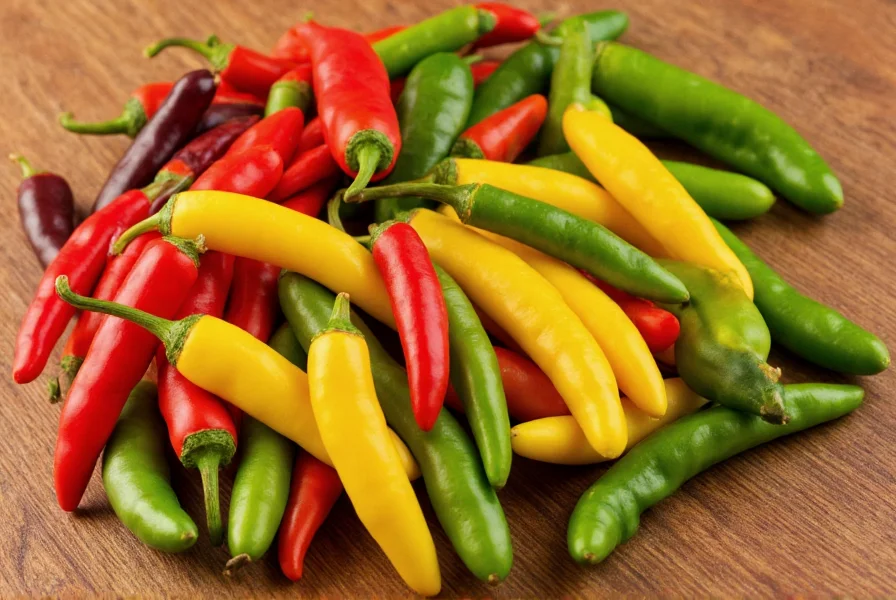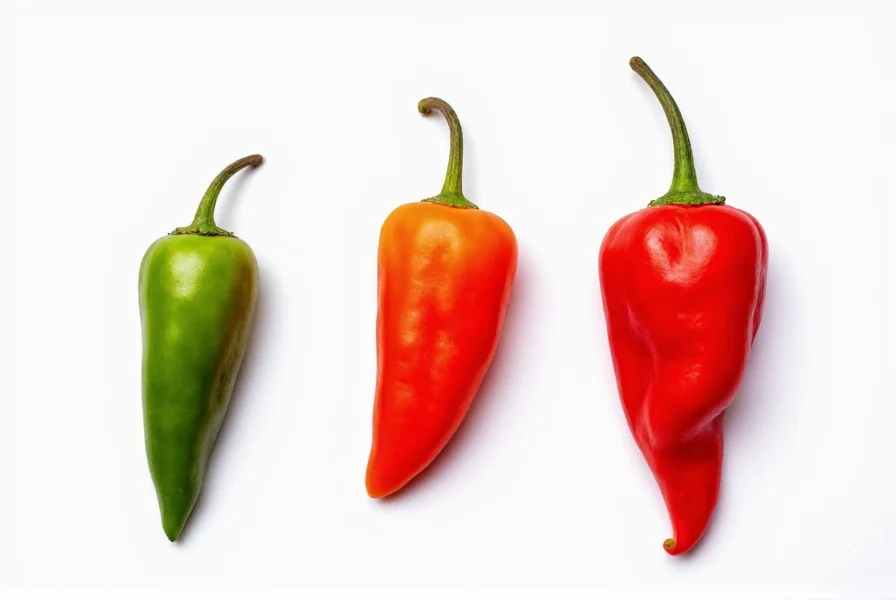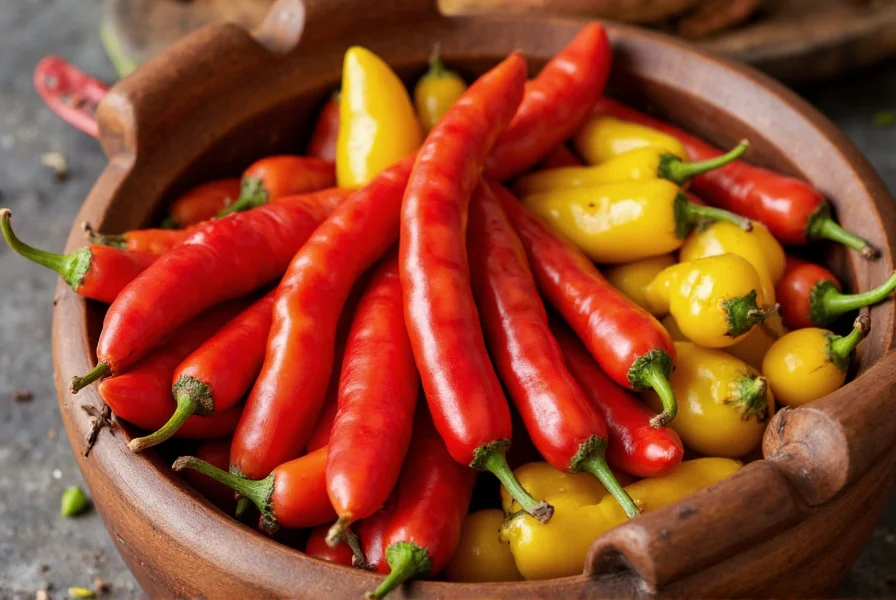There are hundreds of chili pepper varieties worldwide, but the most common types fall into four main categories based on heat level: mild (0-5,000 Scoville units), medium (5,000-30,000), hot (30,000-350,000), and extremely hot (350,000+). Bell peppers, poblanos, and jalapeños represent mild to medium varieties, while habaneros and cayenne peppers deliver significant heat. The current hottest chili recognized is the Carolina Reaper, measuring over 1.5 million Scoville units.
Chili peppers have captivated palates worldwide for thousands of years, evolving from their Mesoamerican origins to become essential ingredients in cuisines across the globe. Understanding the different kinds of chili peppers isn't just about heat tolerance—it's about appreciating their complex flavor profiles, culinary applications, and cultural significance. Whether you're a home cook experimenting with new recipes or a gardening enthusiast looking to expand your pepper patch, knowing the characteristics of various chili types will transform how you approach spice in your kitchen.
Mild Chili Varieties (0-5,000 Scoville Heat Units)
Mild chilies serve as excellent entry points for those new to spicy foods while still offering distinctive flavors that enhance countless dishes. These peppers typically contain minimal capsaicin, the compound responsible for heat.
Bell Peppers
Technically sweet peppers rather than chilies, bell peppers register zero on the Scoville scale. Available in green, red, yellow, and orange varieties, they offer crisp texture and sweet flavor. Green bells are harvested early and have a slightly bitter taste, while red, yellow, and orange varieties ripen longer, developing sweeter profiles. Perfect for stuffing, salads, stir-fries, and as colorful vegetable platters.
Poblano Peppers
Originating from Puebla, Mexico, poblanos measure 1,000-2,000 Scoville units. These large, dark green peppers feature a rich, earthy flavor with subtle heat. When dried, they become ancho chilies, essential in mole sauces. Poblanos excel when roasted and stuffed (chiles rellenos) or incorporated into salsas and stews.
Anaheim Peppers
Measuring 500-2,500 Scoville units, Anaheim peppers (also called California chilies) offer mild heat with a slightly sweet, grassy flavor. Longer and thinner than poblanos, they're perfect for roasting, canning, and making mild green sauces. Many "mild" canned green chilies are actually Anaheim varieties.

Medium Heat Chili Varieties (5,000-30,000 Scoville Heat Units)
These versatile chilies provide noticeable heat while maintaining complex flavor profiles that enhance rather than overwhelm dishes. They represent the sweet spot for many home cooks seeking balanced spice.
Jalapeño Peppers
Perhaps the most recognized chili worldwide, jalapeños measure 2,500-8,000 Scoville units. These medium-sized, cylindrical peppers range from bright green to deep red when mature. They feature a bright, grassy flavor with moderate heat. Essential in salsas, guacamole, nachos, and pickled preparations. When smoked, they become chipotle peppers, adding deep, smoky notes to dishes.
Serrano Peppers
Hotter than jalapeños at 10,000-23,000 Scoville units, serranos are smaller, tapered peppers typically used fresh. They offer a bright, sharp heat with citrus notes. Commonly found in pico de gallo, hot sauces, and as a garnish for tacos. Their thin walls make them ideal for raw applications.
Fresno Peppers
Measuring 2,500-10,000 Scoville units, Fresnos resemble smaller red jalapeños with a fruitier, slightly smoky flavor. They work well in both fresh and cooked applications, particularly in creamy sauces where their heat blends smoothly. Excellent for adding color and moderate spice to dishes.
Hot Chili Varieties (30,000-350,000 Scoville Heat Units)
These chilies deliver significant heat that requires careful handling and measured use in cooking. Their flavors often include distinct fruity or floral notes that balance the intense heat.
Habanero Peppers
One of the most famous hot chilies, habaneros measure 100,000-350,000 Scoville units. Available in orange, red, chocolate, and other colors, they feature tropical fruit notes with intense heat. Essential in Caribbean and Yucatecan cuisines, they shine in hot sauces, marinades, and fruit-based salsas. The Scotch bonnet is a close relative with similar heat and flavor.
Cayenne Peppers
Measuring 30,000-50,000 Scoville units, cayenne peppers are long, thin, and typically dried and ground into the familiar red pepper flakes or powder. They offer clean, straightforward heat with minimal fruitiness. Widely used in Cajun cuisine, stir-fries, and as a seasoning for eggs and roasted vegetables.
Thai Bird's Eye Chilies
These small but mighty peppers measure 50,000-100,000 Scoville units. Common in Southeast Asian cooking, they deliver sharp, immediate heat with minimal aftertaste. Essential in Thai curries, Vietnamese dipping sauces, and Filipino adobo. Their compact size makes them perfect for infusing oils and vinegars.
| Chili Variety | Scoville Range | Flavor Profile | Best Culinary Uses |
|---|---|---|---|
| Bell Pepper | 0 | Sweet, crisp, vegetal | Salads, stuffing, stir-fries |
| Jalapeño | 2,500-8,000 | Grassy, bright, moderate heat | Salsas, nachos, pickled preparations |
| Habanero | 100,000-350,000 | Tropical fruit, floral, intense heat | Hot sauces, Caribbean dishes, fruit salsas |
| Ghost Pepper | 855,000-1,041,427 | Smoky, sweet, then extreme heat | Extreme hot sauces, competitive eating |
| Carolina Reaper | 1,400,000-2,200,000 | Fruity, sweet, then overwhelming heat | Specialty hot sauces, novelty items |
Extremely Hot Chili Varieties (350,000+ Scoville Heat Units)
These chilies represent the upper echelons of heat and require extreme caution when handling. They're primarily used in small quantities for specialty hot sauces and competitive eating challenges.
Ghost Pepper (Bhut Jolokia)
Measuring 855,000-1,041,427 Scoville units, the ghost pepper held the Guinness World Record for hottest chili from 2007-2011. Originating in Northeast India, it features a sweet, smoky flavor that quickly gives way to intense, lingering heat. Used sparingly in Northeast Indian cuisine and increasingly in commercial hot sauces.
Trinidad Moruga Scorpion
With heat levels reaching 2,000,000 Scoville units, this pepper from Trinidad delivers intense, almost immediate heat with fruity undertones. Its bumpy, lantern-shaped appearance belies its extreme potency. Primarily used in specialty hot sauces and novelty food challenges.
Carolina Reaper
Currently holding the Guinness World Record for hottest chili, the Carolina Reaper averages 1,641,183 Scoville units with some specimens exceeding 2.2 million. Developed by Ed Currie in South Carolina, it features a sweet, fruity flavor followed by overwhelming heat. Its distinctive red, bumpy appearance with a characteristic tail makes it easily recognizable. Used almost exclusively in extreme hot sauces and novelty food products.

Understanding Chili Heat and Flavor Profiles
When exploring different kinds of chili peppers, understanding both heat measurement and flavor characteristics is crucial. The Scoville scale, developed by pharmacist Wilbur Scoville in 1912, measures capsaicin concentration. However, modern high-performance liquid chromatography provides more accurate measurements.
Heat perception varies significantly among individuals due to genetic differences in TRPV1 receptors. Factors affecting perceived heat include:
- Ripeness (red peppers are often hotter than green)
- Growing conditions (stress increases capsaicin production)
- Part of the pepper (seeds and placenta contain most capsaicin)
- Individual tolerance and genetics
Flavor profiles extend beyond heat to include:
- Fruitiness (common in habaneros and scorpion peppers)
- Smokiness (developed through drying or roasting)
- Earthy notes (present in poblanos and anchos)
- Citrus undertones (found in serranos and fresnos)
- Floral characteristics (notable in some ghost pepper varieties)
Practical Applications in Cooking
Knowing how to properly use different chili varieties transforms ordinary dishes into extraordinary culinary experiences. Consider these guidelines when working with various chilies:
Substitution Guide for Different Kinds of Chili
When a specific chili isn't available, these substitutions maintain similar heat levels and flavor profiles:
- Replace jalapeños with Fresno peppers or serranos (use less)
- Substitute habaneros with Scotch bonnets (similar heat and flavor)
- Use cayenne powder instead of fresh red chilies (1/4 tsp powder = 1 fresh chili)
- For poblano flavor without heat, try Anaheim peppers or bell peppers with a touch of smoked paprika
Techniques for Managing Heat
To control the spiciness of your dishes when using different chili varieties:
- Remove seeds and white membranes (placenta) to reduce heat significantly
- Add dairy products like yogurt or sour cream to counteract capsaicin
- Cook chilies longer to mellow their heat (except in raw salsas)
- Balance heat with sweetness (honey, fruit, or sugar)
- Use acid (lime juice, vinegar) to brighten and moderate perceived heat
Safety Tips for Handling Hot Chilies
When working with extremely hot chili varieties:
- Wear gloves to prevent skin irritation
- Avoid touching your face, especially eyes
- Wash hands thoroughly with soap after handling
- Use separate cutting boards for hot chilies
- If irritation occurs, apply milk or yogurt to affected area
Regional Varieties and Cultural Significance
Chili peppers have become integral to regional cuisines worldwide, each culture developing unique varieties and applications:
Mexican Chili Traditions
Mexico boasts incredible chili diversity, with regional specialties including:
- Chiltepin: Wild, tiny chilies used throughout Mexico
- Guajillo: Dried mirasol peppers, essential in adobo sauces
- Chipotle: Smoked and dried jalapeños
- Chiles de árbol: Long, thin dried peppers with sharp heat
Asian Chili Variations
Asian cuisines feature distinctive chili types:
- Korean Gochu: Essential for gochujang and kimchi
- Japanese Shishito: Mild, often blistered as appetizers
- Chinese Facing Heaven: Small, extremely hot peppers
- Indonesian Bird's Eye: Ubiquitous in sambals and curries
Caribbean Heat Profiles
The Caribbean islands feature unique hot peppers:
- Scotch Bonnet: Similar to habanero but often fruitier
- Trinidad Perfume: Mild, aromatic pepper used fresh
- Madame Jeanette: Surinamese variety with intense heat
Home Growing Different Kinds of Chili
Growing your own chilies ensures freshness and allows you to experiment with varieties not available commercially. Consider these tips:
- Start seeds indoors 8-10 weeks before last frost
- Provide 6-8 hours of direct sunlight daily
- Use well-draining soil with organic matter
- Water consistently but avoid waterlogging
- Harvest when peppers reach mature color
- Easiest varieties for beginners: Jalapeños, Serranos, Cayenne
- More challenging: Habaneros, Ghost Peppers (require longer growing season)
Remember that stress conditions (like inconsistent watering) can increase capsaicin production, making peppers hotter than expected. For consistent heat levels, maintain stable growing conditions.
Preserving and Processing Different Chili Varieties
Extend your chili harvest with these preservation methods:
Drying Chilies
Air drying, oven drying, or using a food dehydrator works well for most varieties. Dried chilies develop deeper, more complex flavors. Store in airtight containers away from light. Rehydrate by soaking in hot water before use.
Freezing Fresh Chilies
Freezing preserves fresh flavor and heat. Simply wash, dry, and freeze whole peppers in airtight bags. Frozen chilies work well in cooked dishes though they become softer when thawed.
Creating Chili Oils and Vinegars
Infuse mild to medium chilies in oil or vinegar for versatile condiments. Use clean, dry peppers to prevent spoilage. For oil infusions, refrigerate and use within 1 month for safety.
Hot Sauce Production
Creating hot sauce from different kinds of chili allows customization of heat and flavor. Basic hot sauce requires chilies, vinegar, salt, and optional flavorings. Fermentation before blending creates more complex flavors. Always follow food safety guidelines when preserving.
Conclusion: Embracing Chili Diversity
Exploring the world of different kinds of chili peppers reveals an astonishing diversity beyond mere heat. Each variety offers unique flavor profiles, cultural significance, and culinary applications that can transform ordinary dishes into extraordinary experiences. By understanding the characteristics of various chili types—from mild poblanos to extreme Carolina Reapers—you can make informed choices that enhance your cooking rather than overwhelm it. Remember that successful chili use balances heat with complementary flavors, respects individual tolerance levels, and honors the rich cultural traditions from which these remarkable peppers originate. Whether you're growing, buying, or cooking with chilies, approach them with respect for their power and appreciation for their complexity.
What is the mildest chili pepper variety?
Bell peppers are the mildest variety, registering zero on the Scoville scale. Among hot peppers, the poblano (1,000-2,000 Scoville units) and Anaheim (500-2,500 Scoville units) offer the mildest heat while still providing distinctive chili flavor.
How do I reduce the heat of a chili pepper in cooking?
To reduce heat, remove the seeds and white membranes (placenta) where most capsaicin concentrates. Cooking chilies longer can mellow their heat, and balancing with dairy, sweetness, or acid (like lime juice) helps counteract spiciness without losing flavor.
What's the difference between a jalapeño and a serrano pepper?
Jalapeños (2,500-8,000 Scoville units) are larger with thicker walls and a grassy, bright flavor, while serranos (10,000-23,000 Scoville units) are smaller, thinner-walled, and significantly hotter with a sharper, more immediate heat. Serranos work better raw in salsas, while jalapeños are versatile for both raw and cooked applications.
Which chili pepper is currently the hottest in the world?
The Carolina Reaper currently holds the Guinness World Record as the hottest chili pepper, with an average Scoville rating of 1,641,183 units and some specimens measuring over 2.2 million units. It was developed by Ed Currie of the PuckerButt Pepper Company in South Carolina.
Can I substitute dried chilies for fresh ones in recipes?
Yes, but with adjustments. Generally, 1 dried chili equals 2-3 fresh chilies in heat, but flavor profiles differ. Rehydrate dried chilies by soaking in hot water for 20 minutes before use. Note that dried chilies often have more concentrated, complex flavors compared to their fresh counterparts.
Frequently Asked Questions
What is the mildest chili pepper variety?
Bell peppers are the mildest variety, registering zero on the Scoville scale. Among hot peppers, the poblano (1,000-2,000 Scoville units) and Anaheim (500-2,500 Scoville units) offer the mildest heat while still providing distinctive chili flavor.
How do I reduce the heat of a chili pepper in cooking?
To reduce heat, remove the seeds and white membranes (placenta) where most capsaicin concentrates. Cooking chilies longer can mellow their heat, and balancing with dairy, sweetness, or acid (like lime juice) helps counteract spiciness without losing flavor.
What's the difference between a jalapeño and a serrano pepper?
Jalapeños (2,500-8,000 Scoville units) are larger with thicker walls and a grassy, bright flavor, while serranos (10,000-23,000 Scoville units) are smaller, thinner-walled, and significantly hotter with a sharper, more immediate heat. Serranos work better raw in salsas, while jalapeños are versatile for both raw and cooked applications.
Which chili pepper is currently the hottest in the world?
The Carolina Reaper currently holds the Guinness World Record as the hottest chili pepper, with an average Scoville rating of 1,641,183 units and some specimens measuring over 2.2 million units. It was developed by Ed Currie of the PuckerButt Pepper Company in South Carolina.
Can I substitute dried chilies for fresh ones in recipes?
Yes, but with adjustments. Generally, 1 dried chili equals 2-3 fresh chilies in heat, but flavor profiles differ. Rehydrate dried chilies by soaking in hot water for 20 minutes before use. Note that dried chilies often have more concentrated, complex flavors compared to their fresh counterparts.











 浙公网安备
33010002000092号
浙公网安备
33010002000092号 浙B2-20120091-4
浙B2-20120091-4